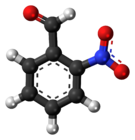2-Nitrobenzaldehyde
| |||
| Names | |||
|---|---|---|---|
| Preferred IUPAC name
2-Nitrobenzaldehyde | |||
| Other names
Nitrobenzaldehyde
ortho-Nitrobenzaldehyde o-Nitrobenzaldehyde | |||
| Identifiers | |||
3D model (JSmol)
|
|||
| ChEBI | |||
| ChEMBL | |||
| ChemSpider | |||
| ECHA InfoCard | 100.008.206 | ||
| EC Number |
| ||
PubChem CID
|
|||
| UNII | |||
CompTox Dashboard (EPA)
|
|||
| |||
| |||
| Properties | |||
| C7H5NO3 | |||
| Molar mass | 151.12 g/mol | ||
| Appearance | Pale yellow crystalline powder | ||
| Melting point | 43 °C (109 °F; 316 K) | ||
| Boiling point | 152 °C (306 °F; 425 K) | ||
| Insoluble | |||
| -68.23·10−6 cm3/mol | |||
| Hazards | |||
| Occupational safety and health (OHS/OSH): | |||
Main hazards
|
Harmful, Potentially mutagenic | ||
| GHS labelling:[1] | |||

| |||
| Warning | |||
| H302, H315, H319, H335, H412 | |||
| P261, P264, P270, P271, P273, P280, P301+P312, P302+P352, P304+P340, P305+P351+P338, P312, P330, P332+P313, P337+P313, P362, P403+P233, P405, P501 | |||
| NFPA 704 (fire diamond) | |||
Except where otherwise noted, data are given for materials in their standard state (at 25 °C [77 °F], 100 kPa).
| |||
2-Nitrobenzaldehyde is an organic compound with the formula O2NC6H4CHO. It is one of three isomers of nitrobenzaldehyde. It contains a nitro group adjacent to the formyl group.[2]
Synthesis
[edit]The nitration of benzaldehyde produces mostly 3-nitrobenzaldehyde. Partly for this reason, 2-nitrobenzaldehyde is prepared by indirect routes.[3] The main routes to nitrobenzaldehyde begin with the nitration of styrene or cinnamic acid followed by the conversions of the resulting 2-nitrostyrene and 2-nitrocinnamic acids, respectively. Cinnamaldehyde can also be nitrated in high-yield to 2-nitrocinnamaldehyde.[4] This compound is then oxidized to 2-nitrocinnamic acid, which is decarboxylated to the 2-nitrostyrene. The vinyl group can be oxidized in a number of different ways to yield 2-nitrobenzaldehyde.[5]
2-Nitrotoluene can be oxidized to yield 2-nitrobenzaldehyde.[6][7]
Alternatively, 2-nitrotoluene as formed above can be halogenated to a 2-nitrobenzyl halide followed by oxidation with DMSO and sodium bicarbonate to yield 2-nitrobenzaldehyde, which is subsequently purified with the creation of a bisulfite adduct.[8]
Uses
[edit]2-Nitrobenzaldehyde is an intermediate in an early route to indigo, a water-insoluble dye commonly used to dye jeans and other fabrics. In the Baeyer-Drewson indigo synthesis, 2-nitrobenzaldehyde condenses with acetone in basic aqueous solution to yield indigo in a one-pot synthesis[9][10] The method was abandoned in the early part of the 20th century, being replaced by routes from aniline.[11]
Given its two relatively reactive groups, 2-nitrobenzaldehyde is a potential starting material for other compounds. Substituted 2-nitrobenzaldehydes can also be used to yield other important compounds based on indigo, such as indigo carmine.
2-Nitrobenzaldehyde has been shown to be a useful photoremovable protecting group for various functions.[12][13]
References
[edit]- ^ "2-Nitrobenzaldehyde". pubchem.ncbi.nlm.nih.gov.
- ^ Brühne, Friedrich; Wright, Elaine (2011). "Benzaldehyde". Ullmann's Encyclopedia of Industrial Chemistry. doi:10.1002/14356007.a03_463.pub2. ISBN 978-3-527-30385-4.
- ^ Brühne, Friedrich; Wright, Elaine (2011). "Benzaldehyde". Ullmann's Encyclopedia of Industrial Chemistry. doi:10.1002/14356007.a03_463.pub2. ISBN 978-3-527-30385-4.
- ^ Robert E. Buckles, M. Peter Bellis (1953). "o-Nitrocinnamaldehyde". Org. Synth. 33: 60. doi:10.15227/orgsyn.033.0060.
- ^ Feng, Bo; Hou, Zhenshan; Wang, Xiangrui; Hu, Yu; Li, Huan; Qiao, Yunxiang (2009-09-01). "Selective aerobic oxidation of styrene to benzaldehyde catalyzed by water-soluble palladium(II) complex in water". Green Chemistry. 11 (9): 1446–1452. doi:10.1039/B900807A. ISSN 1463-9270.
- ^ Alexander Popkov (2005). "Synthesis of 2-Nitrobenzaldehyde from 2-Nitrotoluene". Acta Chim. Slov. 52: 460–462. Archived 2011-06-05 at the Wayback Machine, Alexander Popkov
- ^ S. M. Tsang; Ernest H. Wood; John R. Johnson (1944). "o-Nitrobenzaldehyde". Org. Synth. 24: 75. doi:10.15227/orgsyn.024.0075.
- ^ "Process for the Preparation of 2-Nitrobenzaldehyde". Retrieved 2010-10-18.
- ^ "Indigo Synthesis". Archived from the original on 2011-07-20. Retrieved 2009-07-18.
- ^ "Synthesis of Indigo and Vat Dyeing" (PDF). Archived from the original (PDF) on 2011-07-20. Retrieved 2009-07-18.
- ^ Wiley-VCH, ed. (2003-03-11). "Indigo and Indigo Colorants". Ullmann's Encyclopedia of Industrial Chemistry (1 ed.). Wiley. doi:10.1002/14356007.a14_149.pub2. ISBN 978-3-527-30385-4.
- ^ Šebej, Peter; Šolomek, Tomáš; Hroudná, Ľubica; Brancová, Pavla; Klán, Petr (2009). "Photochemistry of 2-Nitrobenzylidene Acetals". J. Org. Chem. 74 (22): 8647–8658. doi:10.1021/jo901756r. PMID 19824651.
- ^ Kristine L. Willett; Ronald A. Hites (2000). "Chemical Actinometry: Using o-Nitrobenzaldehyde to Measure Lamp Intensity in Photochemical Experiments". J. Chem. Educ. 77 (7): 900. Bibcode:2000JChEd..77..900W. doi:10.1021/ed077p900.




